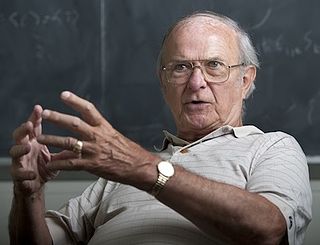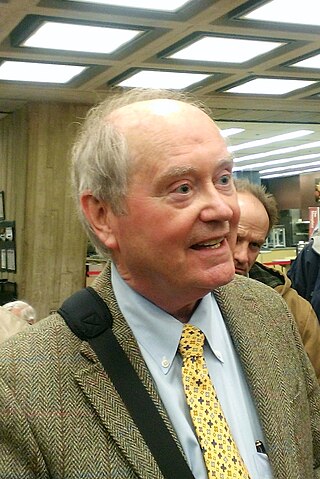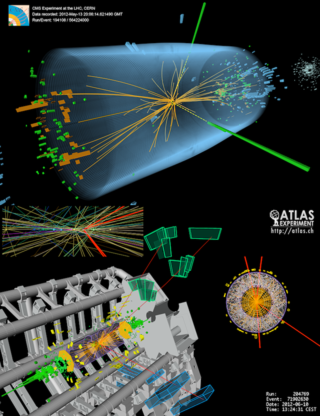Related Research Articles

Particle physics or high-energy physics is the study of fundamental particles and forces that constitute matter and radiation. The field also studies combinations of elementary particles up to the scale of protons and neutrons,while the study of combination of protons and neutrons is called nuclear physics.

Peter Ware Higgs is a British theoretical physicist,Emeritus Professor at the University of Edinburgh,and Nobel Prize laureate for his work on the mass of subatomic particles.

The Large Electron–Positron Collider (LEP) was one of the largest particle accelerators ever constructed. It was built at CERN,a multi-national centre for research in nuclear and particle physics near Geneva,Switzerland.

François,Baron Englert is a Belgian theoretical physicist and 2013 Nobel Prize laureate.

Carl Richard Hagen is a professor of particle physics at the University of Rochester. He is most noted for his contributions to the Standard Model and Symmetry breaking as well as the 1964 co-discovery of the Higgs mechanism and Higgs boson with Gerald Guralnik and Tom Kibble (GHK). As part of Physical Review Letters 50th anniversary celebration,the journal recognized this discovery as one of the milestone papers in PRL history. While widely considered to have authored the most complete of the early papers on the Higgs theory,GHK were controversially not included in the 2013 Nobel Prize in Physics.

Chris Quigg is an American theoretical physicist at the Fermi National Accelerator Laboratory (Fermilab). He graduated from Yale University in 1966 and received his Ph.D. in 1970 under the tutelage of J. D. Jackson at the University of California,Berkeley. He has been an associate professor at the Institute for Theoretical Physics,State University of New York,Stony Brook,and was head of the Theoretical Physics Department at Fermilab from 1977 to 1987.

The Higgs boson,sometimes called the Higgs particle,is an elementary particle in the Standard Model of particle physics produced by the quantum excitation of the Higgs field,one of the fields in particle physics theory. In the Standard Model,the Higgs particle is a massive scalar boson with zero spin,even (positive) parity,no electric charge,and no colour charge that couples to mass. It is also very unstable,decaying into other particles almost immediately upon generation.

Don Lincoln is an American physicist,author,host of the YouTube channel Fermilab,and science communicator. He conducts research in particle physics at Fermi National Accelerator Laboratory,and was an adjunct professor of physics at the University of Notre Dame,although he is no longer affiliated with the university. He received a Ph.D. in experimental particle physics from Rice University in 1994. In 1995,he was a co-discoverer of the top quark. He has co-authored hundreds of research papers,and more recently,was a member of the team that discovered the Higgs boson in 2012.
Joseph Incandela is an American particle physicist,a professor of physics at the University of California,Santa Barbara and currently based at CERN,where he spent two years as the spokesperson for the Compact Muon Solenoid experiment at the Large Hadron Collider.

Guido Tonelli is an Italian particle physicist who was involved with the discovery of the Higgs boson at the Large Hadron Collider. He is a professor of General Physics at the University of Pisa (Italy) and a CERN visiting scientist.

Sau Lan Wu is a Chinese American particle physicist and the Enrico Fermi Distinguished Professor of Physics at the University of Wisconsin-Madison. She made important contributions towards the discovery of the J/psi particle,which provided experimental evidence for the existence of the charm quark,and the gluon,the vector boson of the strong force in the Standard Model of physics. Recently,her team located at the European Organization for Nuclear Research (CERN),using data collected at the Large Hadron Collider (LHC),was part of the international effort in the discovery of a boson consistent with the Higgs boson.

Ashutosh Vijay Kotwal is an American particle physicist of Indian origin. He is the Fritz London Professor of Physics at Duke University,and conducts research in particle physics related to W bosons and the Higgs boson and searches for new particles and forces.
Stephanie A. Majewski is an American physicist at the University of Oregon (UO) researching high energy particle physics at the CERN ATLAS experiment. She worked as a postdoctoral research associate at the Brookhaven National Laboratory prior to joining the faculty at UO in 2012. She was selected for the Early Career Research Program award of the U.S. Department of Energy (DOE),one of 35 scientists in all DOE-supported fields to receive this national honor in 2014.
Mayda Velasco is a physicist and professor in the Department of Physics and Astronomy at Northwestern University. She works in experimental particle physics and is a leading member of the CMS Collaboration at the CERN LHC. She founded COFI and is its first director. She is a pioneer in the physics potential of photon colliders.
Kenneth Arthur Bloom is an American particle physicist. He is a full professor at the University of Nebraska–Lincoln and an Elected Fellow of the American Physical Society.
Sinéad Farrington is a British particle physicist who works on the ATLAS experiment at the Large Hadron Collider.
Stéphane Willocq is an American physicist. He is a professor of physics at the University of Massachusetts Amherst and is involved in the upgrade of the muon trigger with MDT chambers for the high luminosity Large Hadron Collider.

Bernhard Mistlberger is an Austrian theoretical particle physicist known for his significant work in the area of quantum field theory. He is known for multi-loop calculations in quantum chromodynamics (QCD),including the first high-precision theoretical predictions of Higgs and vector boson production at the Large Hadron Collider.

Meenakshi Narain was an Indian-born American experimental physicist. She was a Professor of Physics and Chair of the Department of Physics at Brown University,and was also Chair of the Collaboration Board of U.S. institutions in the Compact Muon Solenoid (CMS) Collaboration. She contributed to the discovery of the top quark in 1995 and Higgs Boson in 2012.
Julia Apostolova Velkovska is a Bulgarian-American high energy particle physicist who is the Cornelius Vanderbilt Professor of Physics at Vanderbilt University. Her research considers nuclear matter in the extreme conditions generated at the Relativistic Heavy Ion Collider. She hopes that this work will help to explain the mechanisms that underpin the strong force.
References
- ↑ Lakhanpal, Aleena (February 24, 2010). "Russian basic sciences research on the decline" . Retrieved April 6, 2021.
- ↑ "Up & Comer". pages.jh.edu. Johns Hopkins Magazine. June 2007. Retrieved April 6, 2021.
- ↑ De Nike, Lisa (April 2, 2007). "Physicist Andrei Gritsan Wins NSF Career Award, Sloan Fellowship". pages.jh.edu. Retrieved April 6, 2021.
- ↑ Gatlin, Latarsha (October 8, 2013). "Johns Hopkins physicists played key roles in historic Higgs particle discovery". hub.jhu.edu. Retrieved April 6, 2021.
- ↑ "What is the Higgs boson? Johns Hopkins physicist discusses Nobel-winning find". hub.jhu.edu. October 8, 2013. Retrieved April 6, 2021.
- ↑ "APS Physics Elects Andrei Gritsan, Michael Falk & Oleg Tchernyshyov as Fellows". physics-astronomy.jhu.edu. September 20, 2019. Retrieved April 6, 2021.